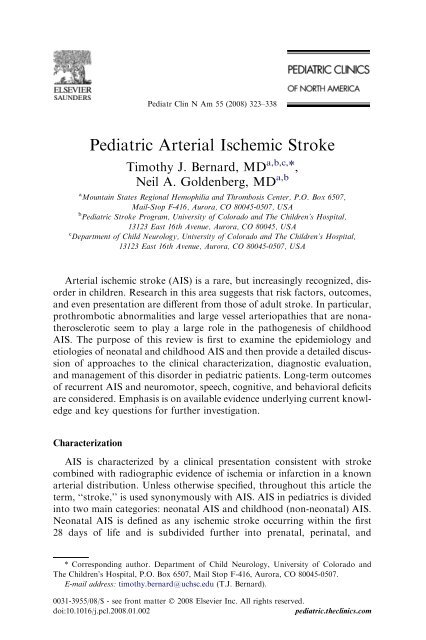Pediatric Clinics of North America - CIPERJ
Pediatric Clinics of North America - CIPERJ
Pediatric Clinics of North America - CIPERJ
Create successful ePaper yourself
Turn your PDF publications into a flip-book with our unique Google optimized e-Paper software.
Pediatr Clin N Am 55 (2008) 323–338<br />
<strong>Pediatric</strong> Arterial Ischemic Stroke<br />
Timothy J. Bernard, MD a,b,c, *,<br />
Neil A. Goldenberg, MD a,b<br />
a Mountain States Regional Hemophilia and Thrombosis Center, P.O. Box 6507,<br />
Mail-Stop F-416, Aurora, CO 80045-0507, USA<br />
b <strong>Pediatric</strong> Stroke Program, University <strong>of</strong> Colorado and The Children’s Hospital,<br />
13123 East 16th Avenue, Aurora, CO 80045, USA<br />
c Department <strong>of</strong> Child Neurology, University <strong>of</strong> Colorado and The Children’s Hospital,<br />
13123 East 16th Avenue, Aurora, CO 80045-0507, USA<br />
Arterial ischemic stroke (AIS) is a rare, but increasingly recognized, disorder<br />
in children. Research in this area suggests that risk factors, outcomes,<br />
and even presentation are different from those <strong>of</strong> adult stroke. In particular,<br />
prothrombotic abnormalities and large vessel arteriopathies that are nonatherosclerotic<br />
seem to play a large role in the pathogenesis <strong>of</strong> childhood<br />
AIS. The purpose <strong>of</strong> this review is first to examine the epidemiology and<br />
etiologies <strong>of</strong> neonatal and childhood AIS and then provide a detailed discussion<br />
<strong>of</strong> approaches to the clinical characterization, diagnostic evaluation,<br />
and management <strong>of</strong> this disorder in pediatric patients. Long-term outcomes<br />
<strong>of</strong> recurrent AIS and neuromotor, speech, cognitive, and behavioral deficits<br />
are considered. Emphasis is on available evidence underlying current knowledge<br />
and key questions for further investigation.<br />
Characterization<br />
AIS is characterized by a clinical presentation consistent with stroke<br />
combined with radiographic evidence <strong>of</strong> ischemia or infarction in a known<br />
arterial distribution. Unless otherwise specified, throughout this article the<br />
term, ‘‘stroke,’’ is used synonymously with AIS. AIS in pediatrics is divided<br />
into two main categories: neonatal AIS and childhood (non-neonatal) AIS.<br />
Neonatal AIS is defined as any ischemic stroke occurring within the first<br />
28 days <strong>of</strong> life and is subdivided further into prenatal, perinatal, and<br />
* Corresponding author. Department <strong>of</strong> Child Neurology, University <strong>of</strong> Colorado and<br />
The Children’s Hospital, P.O. Box 6507, Mail Stop F-416, Aurora, CO 80045-0507.<br />
E-mail address: timothy.bernard@uchsc.edu (T.J. Bernard).<br />
0031-3955/08/$ - see front matter Ó 2008 Elsevier Inc. All rights reserved.<br />
doi:10.1016/j.pcl.2008.01.002<br />
pediatric.theclinics.com





